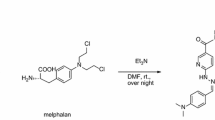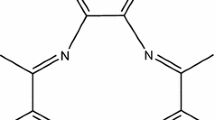Abstract
The purpose of this study was to label a trihydroxyflavone with the name of cirsiliol (3’,4’,5-Trihydroxy-6,7-dimethoxyflavone) with Re/[99mTc]Tc. After that in vivo study in C57 mice with Xenograft melanoma tumor was done. Labeling was optimized, and radiochemical analysis was performed. The high radiochemical yield (> 97%) was achieved for cirsiliol which was stable up to 4 h. Rhenium-labeled cirsiliol characterized the complex formation. High tumor uptake was seen for [99mTc]Tc-cirsiliol (2.16 ± 0.23% ID/g) at 1 h post injection. Because of its ability to accumulate and identify tumors, [99mTc]Tc-cirsiliol has a potential to be considered as new radiotracer for melanoma tumor detecting.






Similar content being viewed by others
References
Parkin DM, Bray F, Ferlay J, Pisani P (2005) Global cancer statistics, 2002. CA Cancer J Clin 55(2):74–108
Ajani JA (2008) Optimizing docetaxel chemotherapy in patients with cancer of the gastric and gastroesophageal junction: evolution of the docetaxel, cisplatin, and 5-fluorouracil regimen. Cancer 113:945–955
Ojima I, Lichtenthal B, Lee S, Wang C, Wang X (2016) Taxane anticancer agents: a patent oerspective. Expert Opin Ther Pat 26:1–20
MacKie RM, Hauschild A, Eggermont AMM (2009) Epidemiology of invasive cutaneous melanoma. Ann Oncol 20:vi1-7
Palmieri G, Ombra M, Colombino M, Casula M, Sini M, Manca A, Paliogiannis P, Ascierto PA, Cossu A (2015) Multiple molecular pathways in melanomagenesis: characterization of therapeutic targets. Front Oncol 5:1–16
Tang T, Eldabaje R, Yang L (2016) Current status of biological therapies for the treatment of metastatic melanoma. Anticancer Res 36:3229–3242
Venturelli S, Burkard M, Biendl M, Lauer UM, Frank J, Busch C (2016) Prenylated chalcones and flavonoids for the prevention and treatment of cancer. Original Res Article Nutr 32:1171–1178
Priyadarshani G, Amrutkar S, Nayak A, Banerjee UC, Kundu CN, Guchhait SS (2016) Scaffold-hopping of bioactive flavonoids: Discovery of aryl-pyridopyrimidinones as potentanticancer agents that inhibit catalytic role of topoisomerase II. Eur J Med Chem 122:43–54
Hatahet T, Morille M, Hommoss A, Dorandeu C, Müller RH, Bégu S (2016) Dermal quercetin smartCrystals®: formulation development, antioxidant activity and cellular safety. Eur J Pharm Biopharm 102:51–63
Nunes BC, Martins MM, Chang R, Morais SAL, Nascimento EA, Oliveira A, Cunha LCS, Silva CV, Teixeira TL, Ambrósio MALV, Martins CHG, Aquino FJT (2016) Antimicrobial activity, cytotoxicity and selectivity index of Banisteriopsis laevifolia (A. Juss.) B. Gates leaves. Ind Crops Prod 92:277–289
SeleemD PV, Murata RM (2016) Review of flavonoids: a diverse group of natural compounds with Anti-Candida albicans activity in vitro. Arch Oral Biol 27:1–26
Viola H, Wasowski C, Marder M, Wolfman C, Paladini AC, Medina JH (1997) Sedative and hypnotic properties of Salvia guaranitica St. Hll and of its active principle. Cirsiliol Phytomed 4:47–51
Bai N, He H, Zhou Z, Lai C, Zhang L, Quan Z, Shao X, Pan M, Ho C (2010) Flavonoids from Rabdosi arubescens exert anti-inflammatory and growth inhibitory effect against human leukemia HL-60 cells. Food Chem 122:831–835
Nagao T, Abe F, Kinjo J, Okabe H (2002) Antiproliferative Constituents in Plants 10. Flavones from the leaves of Lantana montevidensis BRIQ and consideration of structure-activity relationship. Biol Pharm Bull 25(7):875–879
Hosseinimehr SJ, Ahmadi A, Taghvai R (2010) Preparation and biodistribution study of technetium-99m-labeled quercetin as a potential radical scavenging agent. J Radioanal Nucl Chem 284:563–566
Ramdhani D, Sriyani ME, Nabila SF (2020) The optimization method for synthesis of technetium-99m-luteolin as radiotracer in the development of cancer drugs from flavonoid. J Adv Pharm Technol Res 11(2):59–63
Bernardo LC, Oliveira MBN, da Silva CR, Moura RS, Bernardo-Filho M (2001) Rutin labeled with technetium-99m and its biodistribution in wistar rats. J Lab Comp Radioph 44(Suppl. 1):S645–S647
Mikaeili A, Erfani M, Shafiei M, Kobarfard F, Abdi K, Sabzevari O (2018) Development of a 99mTc-labeled CXCR4 antagonist derivative as a new tumor radiotracer. Cancer Biother Radiopharma 33:1–8
Dewanjee MK (1990) The chemistry of 99mTc-labeled radiopharmaceuticals. Semin Nucl Med 20:5–27
Ravishankar D, Rajora AK, Greco F, Osborn HMI (2013) Flavonoids as prospective compounds for anti-cancer therapy. Int J Biochem Cell Biol 45:2821–2831
Uehara A, Kitajima J, Kokubugata G, Iwashina T (2014) Further characterization of foliar flavonoids in Crossostephium chinense and their geographic variation. Natural Product Commun 9:163–164
Dowling S, Regan F, Hughes H (2010) The characterisation of structural and antioxidant properties of isoflavone metal chelates. J Inorg Biochem 104(10):1091–1098
Mariola Samsonowicz E, Regulska M (2017) Hydroxyflavone metal complexes-molecular structure, antioxidant activity and biological effects. Chem Biol Interact 273:245–256
Selvaraj S, Krishnaswamy S, Devashya V, Sethuraman S, Krishnan UM (2014) Flavonoid-metal ion complexes: a novel class of therapeutic agents: flavonoid-metal ion complexes. Med Res 34(4):677–702
Peters T Jr (1989) Serum albumin. Adv Pro Chem 37:161–245
Brookes PS, Digerness SB, Parks DA, Darley-Usmar V (2002) Mitochondrial function in response to cardiac ischemia-reperfusion after oral treatment with quercetin. Free Radic Biol Med 32(11):1220–1228
Acknowledgements
This research has been part of a Ph.D. thesis and supported by Shahid Beheshti University and Nuclear Science and Technology Research Institute, Tehran, Iran.
Author information
Authors and Affiliations
Corresponding author
Ethics declarations
Conflict of interest
The authors declare no conflict of interest.
Additional information
Publisher’s note
Springer Nature remains neutral with regard to jurisdictional claims in published maps and institutional affiliations.
Rights and permissions
About this article
Cite this article
Ghalbi Ahangari, M., Moridi Farimani, M. & Erfani, M. Assessment of Re/[99mTc]Tc-cirsiliol as a potential radiotracer to detect melanoma tumor. J Radioanal Nucl Chem 328, 847–855 (2021). https://doi.org/10.1007/s10967-021-07713-z
Received:
Accepted:
Published:
Issue Date:
DOI: https://doi.org/10.1007/s10967-021-07713-z




